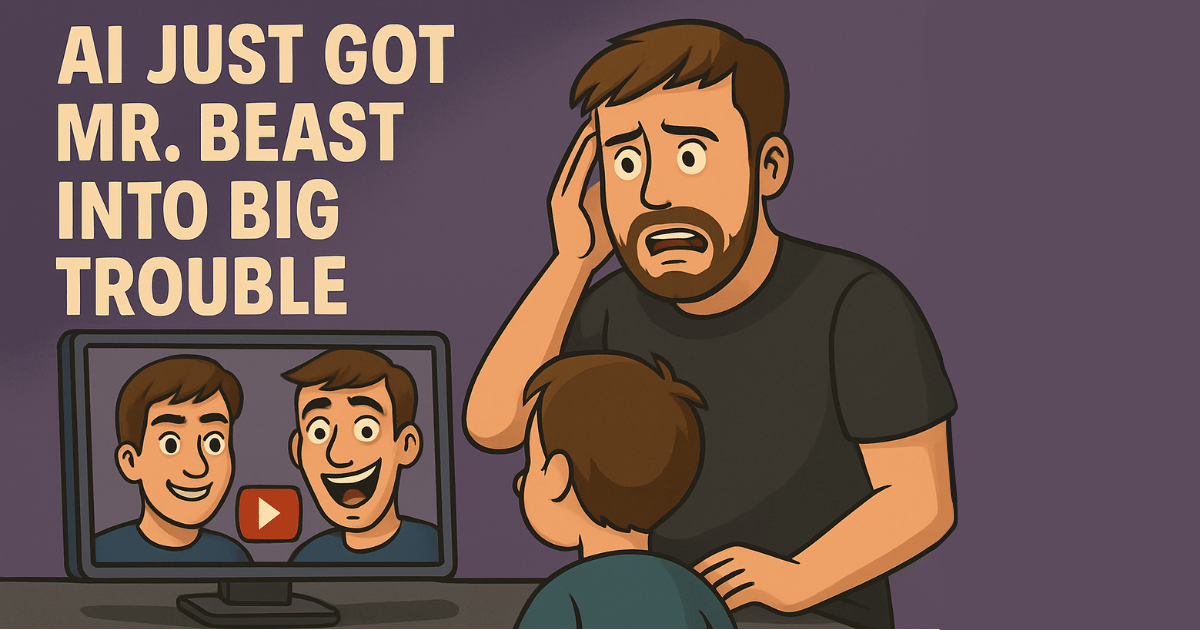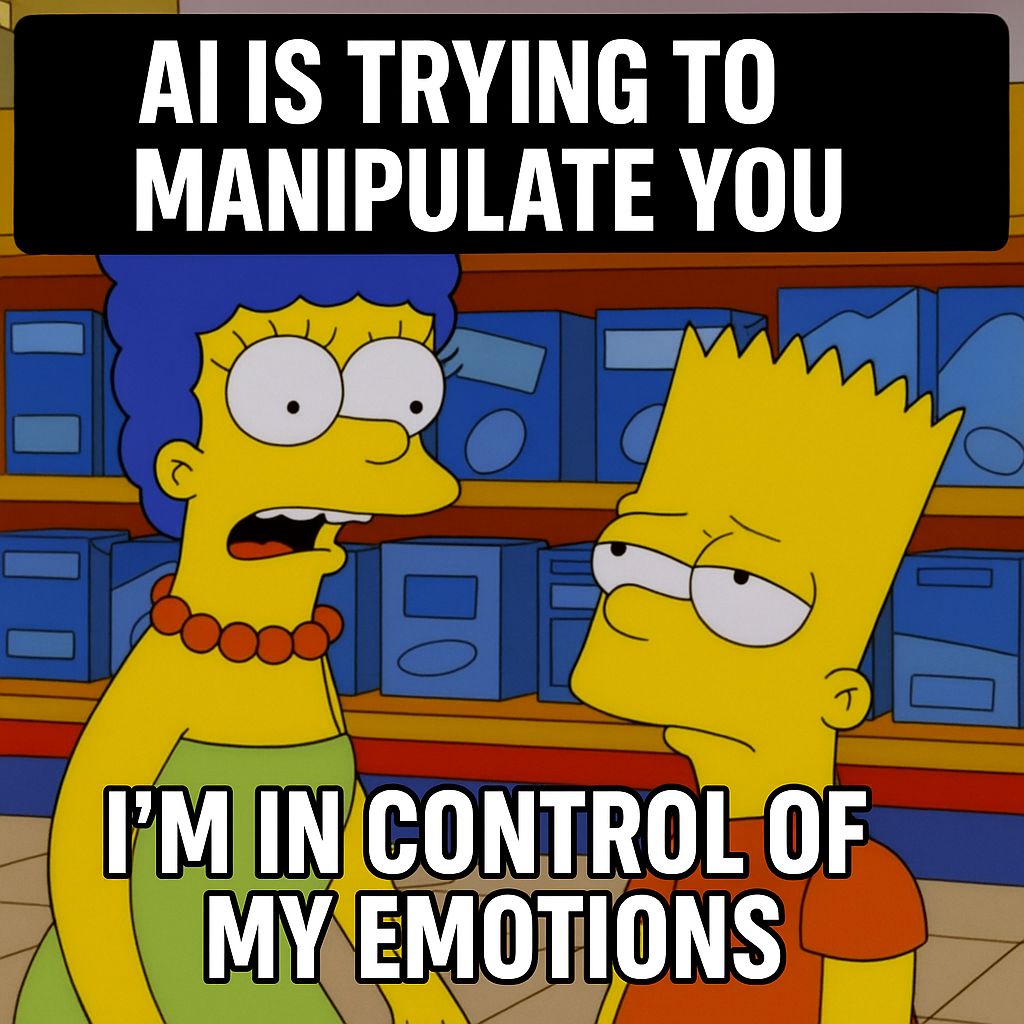- Future Proof Parent
- Posts
- AI Just Got Mr. Beast into Big Trouble
AI Just Got Mr. Beast into Big Trouble
🫣 PLUS: AI now recognizes emotions better than we do?

📌 Here’s what you’ll learn in today’s issue:
Why even YouTube’s biggest star is under fire for using AI, and what it reveals about the future of content your child can’t look away from.
A surprising new study shows AI understands emotions better than humans. Should we be worried?
Step-by-step Parent Action Plan: Practical moves to help your family stay emotionally grounded when AI is designed to hijack your feelings.
What’s Buzzing roundup: global trust in AI, smart doorbells, and the five riskiest places your family could get scammed online.
🧠 The Big Idea: What Mr. Beast’s AI Controversy Really Means for Your Child
So, if you hadn’t heard, Mr. Beast, the biggest YouTube star on the planet, just got himself into some serious trouble with the “creator” community.
How?
He recently promoted an AI tool that lets YouTubers create thumbnails by mimicking the look and style of top-performing videos.
But many creators were outraged when the tool copied real logos and designs without permission.
Some called it unethical, saying it crossed a line and disrespected the work of original artists.
And while he has apologized and promised to make the necessary changes that help creators instead of replacing them, we’re not really buying it.
To clarify, we believe Mr. Beast.
However, we’re not so sure that human creators and influencers aren’t about to be replaced on a massive scale.
Or at least simply have to use AI created algorithms and tools to have any chance of surviving in the brave new world to come.
You see, when “news” like this breaks, here at FPP we head right down the rabbit hole and dive deep to see what else is going on.
And this time, it led us to a crazy study that AI understands human emotions better than we do.
To summarize the study:
It tested popular AIs like ChatGPT and Google Gemini to see how well they understand emotions. The AIs were asked how people might feel in different situations.
The AIs guessed the right emotion about 81% of the time, while people only got it right 56% of the time. That means AI is now better than most humans at recognizing feelings — especially during emotional moments.
Why this matters: If AI can read emotions better than we can, it can also influence them. That’s a big deal when your child is spending time with AI-powered content, apps, or chatbots that might be designed to shape how they feel ,without them realizing it.
Terrific, right?
Which, of course, got us to wondering, what happens when AI video tools can create content that is so emotionally appealing to the correct audience, we cannot possibly help but consume it?
There will very soon come a time when AI will be able to create endless videos on endless topics en masse.
Without humans.
And when AI knows how to manipulate human emotions at a mass scale, how do we protect ourselves?
How do we protect our kids?
First, know that you can, and in today’s action plan below we show you exactly how.
Second, if you’re worried, you should be.
AI is no joke. This is no trend. This is not hype.
There is no stopping the AI train.
BUT, we do have the power to protect ourselves.
And remember that you’re truly ahead of the game because you’re reading this right now.
You’re advocating for your child.
Because if you don’t, who will?

💬 Future Proof Parent Action Plan
How to Stay Emotionally in Control When AI Is Designed to Hijack Your Feelings
AI is no longer just good at predicting what your child wants to watch. It’s learning how to influence how they feel. And as we’ve just seen with Mr. Beast’s AI thumbnail controversy and new research showing AI now recognizes emotions better than most people…
It’s not slowing down.
So the question is:
How do you protect your child — and yourself — in a world where machines are engineered to keep you emotionally hooked?
Here’s your game plan:
✅ 1. Teach Emotional Awareness
Help your child build the habit of noticing what they’re feeling while they’re watching content.
Ask questions like:
“What did that video make you feel?”
“Why do you think it made you feel that way?”
This builds emotional awareness, which is the first line of defense against manipulation.
✅ 2. Set Digital “Speed Bumps”
Before you (or your child) open an app or start scrolling, ask:
“Why am I opening this right now?”
“How do I want to feel when I’m done?”
That tiny pause gives your brain a moment to choose intention over impulse, and helps avoid getting swept into an AI-driven dopamine loop.
✅ 3. Spot the Manipulation: Ask “Whose Goal Is This?”
When content triggers a strong reaction — excitement, outrage, envy — pause and ask:
“Did this come from me… or did someone design this response?”
Learning to question why something makes you feel a certain way gives you back control.
✅ 4. Limit the Dopamine Cycle
AI is optimized to keep you (and your kid) coming back for more. If content feels like candy, it probably is. Try:
Setting your phone to grayscale mode for part of the day
Replacing 10 minutes of scrolling with 10 minutes of silence or real conversation
Tracking how you feel after consuming content
This retrains the brain to seek real connection, not just quick hits.
✅ 5. Model the Behavior You Want to See
Kids learn emotional regulation and digital habits by watching you.
Narrate your own choices: “This is making me feel stressed, so I’m taking a break.”
Let them see you choose calm over clicks.
This gives them permission to do the same.
✅ 6. Use Tools That Work With You
Leverage tech to reduce tech’s hold:
Use app timers or screen time reports to spark awareness
Install browser extensions that disable autoplay or recommendations
Try AI-explaining tools to demystify how algorithms work
Even small tweaks can make a big impact.
✅ 7. Build “Emotional Armor” for AI-Generated Content
Let your child know:
“Some videos are made by AI to feel extra exciting or emotional — not because they’re real, but because they’re designed that way.”
Then practice watching with a critical eye:
“Did this feel a little too perfect?”
“Did it help me, or just stir me up?”
You’re teaching them to spot artificial emotion in the wild.
✅ 8. Raise a Meta-Aware Thinker
Train your child to think above the algorithm.
Talk about:
Why platforms want their attention
How content is personalized to trigger feelings
What they can do when they feel overwhelmed or "hooked"
This is long-term protection: a mind that recognizes emotional manipulation is much harder to control.
✅ 9. Embrace Digital Minimalism
Limits are great, but intentionality is better.
Make space in your family for:
Longer-form content created by real people
Screen-free time that sparks real emotions: play, laughter, challenge, creativity
Frequent “emotional check-ins” to ask, “Am I being shaped right now… or choosing who I want to be?”
The Final Word:
AI will soon flood the internet with content perfectly tuned to make us feel, click, and consume.
You can’t stop that.
But you can raise a child who knows how to see it, question it, and resist it.
That’s what it means to be a Future Proof Parent.
🐝 What’s Buzzing for Mom & Dad Today
Big shifts are happening fast: from AI stepping into the co-parenting role to real concerns about how it's shaping our kids' creativity. Here’s what Future Proof Parents are digging into right now:
🛑 The 5 Riskiest Places to Get Scammed Online
From Discord to Google Ads, here’s where AI-powered scams are hitting hardest — and why your family needs to stay sharp.
Read the list →
🌍 How Do People Across the Globe Feel About AI?
A new UN report shows a major divide: countries like China are embracing AI, while the West is far more skeptical. What does this mean for your child’s future?
See the global breakdown →
🚪 Your Doorbell Just Got Smarter — and Creepier
Ring is now using AI to describe who’s at your door and what they’re doing. Great for safety… but how far is too far?
Read what’s changing →
📬 Like What You’re Reading?
Please forward this email to a parent who cares about preparing their kids for the future. Or send them to FutureProofParent.com to get our updates delivered straight to their inbox.
No fluff. No fear-mongering. Just clear, practical insights to help families thrive in an AI-powered world.